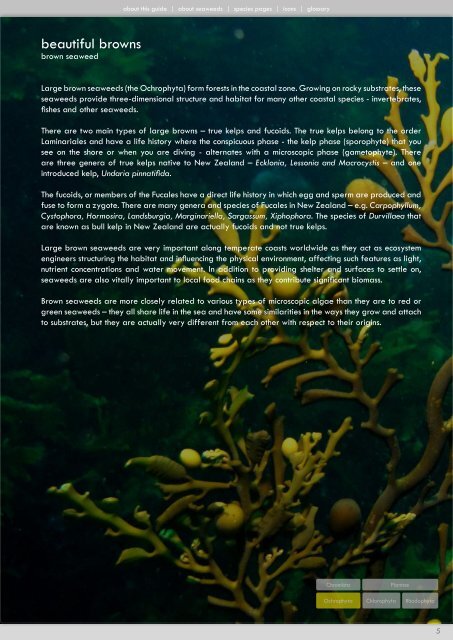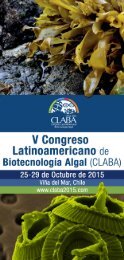stunning
Beautiful_Browns_Ver1-2016-NIWA
Beautiful_Browns_Ver1-2016-NIWA
Create successful ePaper yourself
Turn your PDF publications into a flip-book with our unique Google optimized e-Paper software.
about this guide | about seaweeds | species pages | icons | glossary<br />
beautiful browns<br />
brown seaweed<br />
Large brown seaweeds (the Ochrophyta) form forests in the coastal zone. Growing on rocky substrates, these<br />
seaweeds provide three-dimensional structure and habitat for many other coastal species - invertebrates,<br />
fishes and other seaweeds.<br />
There are two main types of large browns – true kelps and fucoids. The true kelps belong to the order<br />
Laminariales and have a life history where the conspicuous phase - the kelp phase (sporophyte) that you<br />
see on the shore or when you are diving - alternates with a microscopic phase (gametophyte). There<br />
are three genera of true kelps native to New Zealand – Ecklonia, Lessonia and Macrocystis – and one<br />
introduced kelp, Undaria pinnatifida.<br />
The fucoids, or members of the Fucales have a direct life history in which egg and sperm are produced and<br />
fuse to form a zygote. There are many genera and species of Fucales in New Zealand – e.g. Carpophyllum,<br />
Cystophora, Hormosira, Landsburgia, Marginariella, Sargassum, Xiphophora. The species of Durvillaea that<br />
are known as bull kelp in New Zealand are actually fucoids and not true kelps.<br />
Large brown seaweeds are very important along temperate coasts worldwide as they act as ecosystem<br />
engineers structuring the habitat and influencing the physical environment, affecting such features as light,<br />
nutrient concentrations and water movement. In addition to providing shelter and surfaces to settle on,<br />
seaweeds are also vitally important to local food chains as they contribute significant biomass.<br />
Brown seaweeds are more closely related to various types of microscopic algae than they are to red or<br />
green seaweeds – they all share life in the sea and have some similarities in the ways they grow and attach<br />
to substrates, but they are actually very different from each other with respect to their origins.<br />
Chromista<br />
Plantae<br />
Ochrophyta Chlorophyta Rhodophyta<br />
5



